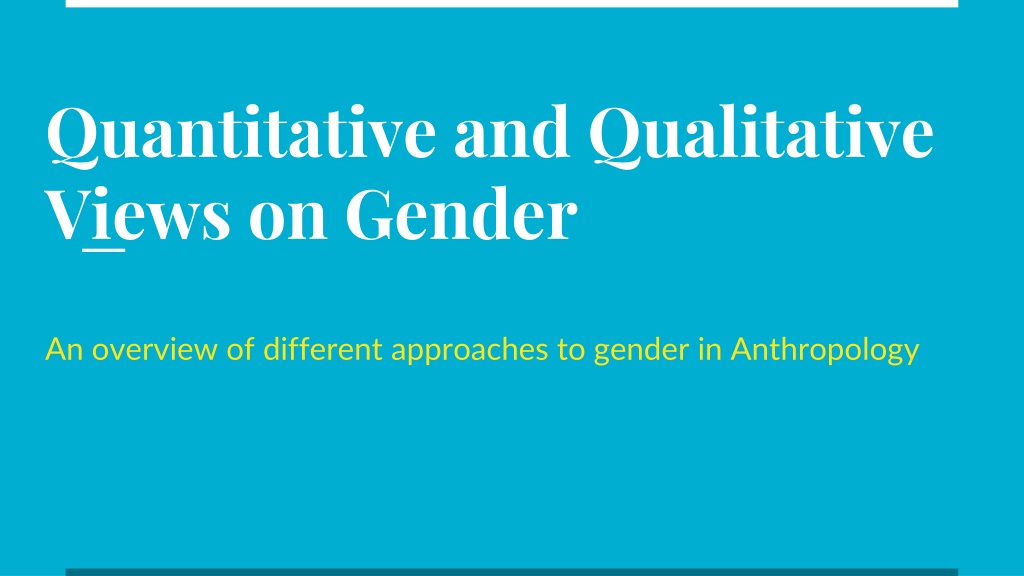Approaches to Gender Studies in Anthropology
This presentation provides an overview of qualitative and quantitative research methodologies in Anthropology focusing on Gender Studies. It explores topics like masculinity, homosociality, and gendered spaces, reflecting on the concepts of gender construction and performance. The research on fraternity men's perceptions of masculinity sheds light on hybrid masculinity, individual gender expression, and the role of homosocial spheres in shaping identity. The findings contribute to gender/feminist theories, emphasizing the need for detailed data analysis despite the limitations of small-scale research.
Download Presentation

Please find below an Image/Link to download the presentation.
The content on the website is provided AS IS for your information and personal use only. It may not be sold, licensed, or shared on other websites without obtaining consent from the author. Download presentation by click this link. If you encounter any issues during the download, it is possible that the publisher has removed the file from their server.
E N D
Presentation Transcript
Quantitative and Qualitative Views on Gender An overview of different approaches to gender in Anthropology
This Presentation Explore examples of qualitative and quantitative anthropological research in the field of Gender Studies Qualitative: Brothers as Men: Masculinity, Homosociality, and Violence Among Fraternity Men Quantitative: Gendered Space Investigate the pros/cons for these types of research Discuss future topics for each of these methodologies
Gender Studies Interdisciplinary field Includes people from throughout the social sciences and humanities Topics Constructions of gender Gender performance Gender ideology Gender status/hegemonies Gender Studies and Anthropology Anthro has a long history of being on the forefront of research into gender
Brothers as Men - Introduction My own independent research Served as the research for my Honors Thesis, my University Scholar Project, and my IDEA Grant Project Conducted Fall 2019 Research was conducted in the Fall Analysis and write-up were done the next semester Research questions: How do fraternity men construct, perform, and understand gender and masculinity? How does this affect their interactions with other men and other people in general?
Brothers as Men - Methodology Interviews with 55 fraternity men Self-selected sample Recruited through flyers, word of mouth, etc. Compensated with gift cards Semi-structured interviews Interviews loosely following an interview schedule There were also other elements such as using Likert Scales and Cultural Domain Analysis Qualitative analysis Required transcription of all interviews Transcripts are then gone through with a fine toothed comb to look for patterns/commonalities
Brothers as Men - Conclusions Findings Men seemed to emphasize hybrid masculinity Men also acknowledged that gender was constructed and stressed that gender expression was an individual choice Men stressed that homosocial spheres (fraternities) were a necessary refuge for them Conclusions Contextualize these findings into gender/feminist theory Gain insights/refine into those theories through highly detailed data However this is constrained by the small scale of the research
Gendered Space - Introduction Feminist cross-cultural research Conducted by Daphne Spain Published in 1992 How does the partitioning of different spaces by gender affect women s status/power in various areas? Types of spatial separation Partitioning in dwellings Men s huts/ceremonial houses/clubhouses Separation while working Types of women s status Power in kin networks Preference for women in inheritance Control over labor and property
Gendered Space - Methodology Sampling Standard Cross-Cultural Sample 186 cultures Selected to be geographically representative, but also independent Only uses half of the sample Coding Determine women s status and spatial separation variables in each culture Uses variables that were already coded by other researchers Quantitative Analysis Run statistical tests on these coded and quantified values Uses gamma
Gendered Space - Conclusions Findings Supported: Partitioning of space in dwellings and spatially separated labor divided by gender are both negatively associated with women s power in kin networks Partially supported: Men s huts are negatively associated with power in kinship, women s preference in inheritance, and control of labor and property Partitioning of space in dwellings is negatively associated with women s preference in inheritance Conclusions Space that is divided by gender contributes to the subordination of women cross-culturally Larger scale conclusions that are generalizable However, little detail is gained
Strengths and Weaknesses Question: Qualitative: General, thematic, less measurable Quantitative: Specific, quantifiable, measurable Methodology Qualitative: Time consuming, resource intensive, sampling issues Quantitative: More predictable, better sampling, relying on other researcher s data Findings Qualitative: Detailed, multi-faceted, amorphous Quantitative: Specific, generalizable, lacking detail
Conclusions Two methods, one discipline Many different ways of investigating the same questions Emblematic of the diverse field that is Anthropology Why not both? Each methodology has strengths and weakness, using both could strengthen research Future Research Qualitative: Understand more about homosociality and constructions of masculinity among men Quantitative: Investigate the effect of the intensity of masculinity and male institutions on women s status cross-culturally























